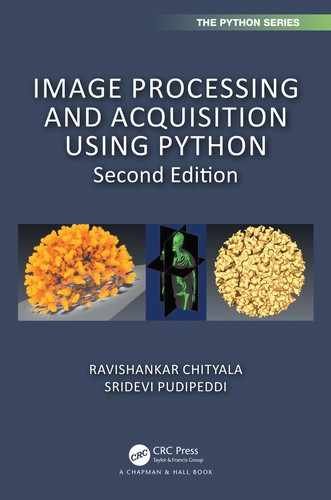Book Description
Image Processing and Acquisition using Python provides readers with a sound foundation in both image acquisition and image processing—one of the first books to integrate these topics together. By improving readers’ knowledge of image acquisition techniques and corresponding image processing, the book will help them perform experiments more effectively and cost efficiently as well as analyze and measure more accurately. Long recognized as one of the easiest languages for non-programmers to learn, Python is used in a variety of practical examples.
A refresher for more experienced readers, the first part of the book presents an introduction to Python, Python modules, reading and writing images using Python, and an introduction to images. The second part discusses the basics of image processing, including pre/post processing using filters, segmentation, morphological operations, and measurements. The second part describes image acquisition using various modalities, such as x-ray, CT, MRI, light microscopy, and electron microscopy. These modalities encompass most of the common image acquisition methods currently used by researchers in academia and industry.
Features
- Covers both the physical methods of obtaining images and the analytical processing methods required to understand the science behind the images.
- Contains many examples, detailed derivations, and working Python examples of the techniques.
- Offers practical tips on image acquisition and processing.
- Includes numerous exercises to test the reader’s skills in Python programming and image processing, with solutions to selected problems, example programs, and images available on the book’s web page.
New to this edition
- Machine learning has become an indispensable part of image processing and computer vision, so in this new edition two new chapters are included: one on neural networks and the other on convolutional neural networks.
- A new chapter on affine transform and many new algorithms.
- Updated Python code aligned to the latest version of modules.
Table of Contents
- Cover
- Half Title
- Series Page
- Title Page
- Copyright Page
- Dedication
- Contents
- Foreword
- Preface
- Preface to the First Edition
- Introduction
- Authors
- List of Symbols and Abbreviations
- Part I: Introduction to Images and Computing using Python
- Part II: Image Processing using Python
- 4. Spatial Filters
- 5. Image Enhancement
- 5.1 Introduction
- 5.2 Pixel Transformation
- 5.3 Image Inverse
- 5.4 Power Law Transformation
- 5.5 Log Transformation
- 5.6 Histogram Equalization
- 5.7 Contrast Limited Adaptive Histogram Equalization (CLAHE)
- 5.8 Contrast Stretching
- 5.9 Sigmoid Correction
- 5.10 Local Contrast Normalization
- 5.11 Summary
- 5.12 Exercises
- 6. Affine Transformation
- 7. Fourier Transform
- 8. Segmentation
- 9. Morphological Operations
- 10. Image Measurements
- 11. Neural Network
- 12. Convolutional Neural Network
- Part III: Image Acquisition
- 13. X-Ray and Computed Tomography
- 14. Magnetic Resonance Imaging
- 15. Light Microscopes
- 16. Electron Microscopes
- Appendix A: Image Processing and Acquisition using Python
- Appendix B: Image Processing and Acquisition using Python
- Appendix C: Introduction to ImageJ
- Appendix D: Matlab® and Numpy Functions
- Bibliography
- Index
